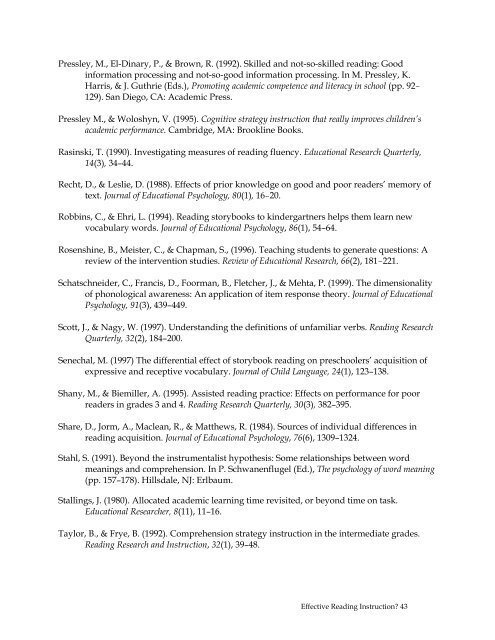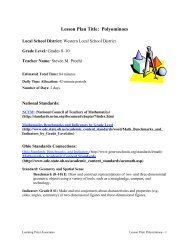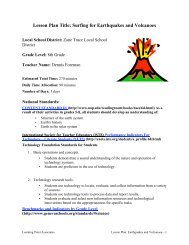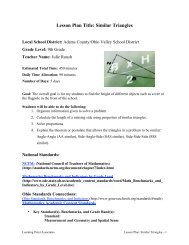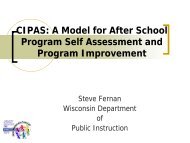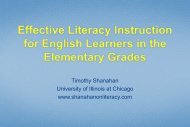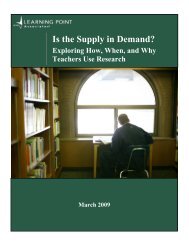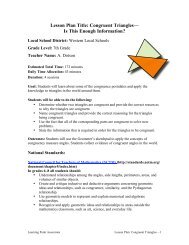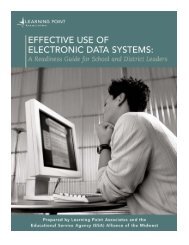A Closer Look at the Five Essential Components - Learning Point ...
A Closer Look at the Five Essential Components - Learning Point ...
A Closer Look at the Five Essential Components - Learning Point ...
Create successful ePaper yourself
Turn your PDF publications into a flip-book with our unique Google optimized e-Paper software.
Pressley, M., El-Dinary, P., & Brown, R. (1992). Skilled and not-so-skilled reading: Good<br />
inform<strong>at</strong>ion processing and not-so-good inform<strong>at</strong>ion processing. In M. Pressley, K.<br />
Harris, & J. Guthrie (Eds.), Promoting academic competence and literacy in school (pp. 92–<br />
129). San Diego, CA: Academic Press.<br />
Pressley M., & Woloshyn, V. (1995). Cognitive str<strong>at</strong>egy instruction th<strong>at</strong> really improves children’s<br />
academic performance. Cambridge, MA: Brookline Books.<br />
Rasinski, T. (1990). Investig<strong>at</strong>ing measures of reading fluency. Educ<strong>at</strong>ional Research Quarterly,<br />
14(3), 34–44.<br />
Recht, D., & Leslie, D. (1988). Effects of prior knowledge on good and poor readers’ memory of<br />
text. Journal of Educ<strong>at</strong>ional Psychology, 80(1), 16–20.<br />
Robbins, C., & Ehri, L. (1994). Reading storybooks to kindergartners helps <strong>the</strong>m learn new<br />
vocabulary words. Journal of Educ<strong>at</strong>ional Psychology, 86(1), 54–64.<br />
Rosenshine, B., Meister, C., & Chapman, S., (1996). Teaching students to gener<strong>at</strong>e questions: A<br />
review of <strong>the</strong> intervention studies. Review of Educ<strong>at</strong>ional Research, 66(2), 181–221.<br />
Sch<strong>at</strong>schneider, C., Francis, D., Foorman, B., Fletcher, J., & Mehta, P. (1999). The dimensionality<br />
of phonological awareness: An applic<strong>at</strong>ion of item response <strong>the</strong>ory. Journal of Educ<strong>at</strong>ional<br />
Psychology, 91(3), 439–449.<br />
Scott, J., & Nagy, W. (1997). Understanding <strong>the</strong> definitions of unfamiliar verbs. Reading Research<br />
Quarterly, 32(2), 184–200.<br />
Senechal, M. (1997) The differential effect of storybook reading on preschoolers’ acquisition of<br />
expressive and receptive vocabulary. Journal of Child Language, 24(1), 123–138.<br />
Shany, M., & Biemiller, A. (1995). Assisted reading practice: Effects on performance for poor<br />
readers in grades 3 and 4. Reading Research Quarterly, 30(3), 382–395.<br />
Share, D., Jorm, A., Maclean, R., & M<strong>at</strong><strong>the</strong>ws, R. (1984). Sources of individual differences in<br />
reading acquisition. Journal of Educ<strong>at</strong>ional Psychology, 76(6), 1309–1324.<br />
Stahl, S. (1991). Beyond <strong>the</strong> instrumentalist hypo<strong>the</strong>sis: Some rel<strong>at</strong>ionships between word<br />
meanings and comprehension. In P. Schwanenflugel (Ed.), The psychology of word meaning<br />
(pp. 157–178). Hillsdale, NJ: Erlbaum.<br />
Stallings, J. (1980). Alloc<strong>at</strong>ed academic learning time revisited, or beyond time on task.<br />
Educ<strong>at</strong>ional Researcher, 8(11), 11–16.<br />
Taylor, B., & Frye, B. (1992). Comprehension str<strong>at</strong>egy instruction in <strong>the</strong> intermedi<strong>at</strong>e grades.<br />
Reading Research and Instruction, 32(1), 39–48.<br />
Effective Reading Instruction? 43


